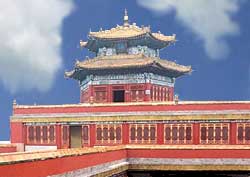Chengde Mountain Resort
 Why the
Chengde Mountain Resort
is special
Why the
Chengde Mountain Resort
is specialIt was the summer resort of emperors of the Qing Dynasty (1644-1911). It was their official residence, seat and hunting ground from May to September. This let them escape the summer heat of Beijing.
Chengde Mountain Resort tips and insights
How to pronounce
Chengde: ch'ung-duh
Setting
The Chengde Mountain Resort's palace complex, pavilions, temples, extensive gardens, meadows and forests lie in a scenic valley and are well preserved.
Unlike large palace complexes built elsewhere in China (which includes the Forbidden City in Beijing), the Chengde structures were built to fit harmoniously with the landscape.
Architecture
The architects of the palace buildings and gardens purposely borrowed design elements from different regions of China, including Tibet. The emperor believed this eclectic approach would please his subjects around the country.
Construction period
It took 89 years (1703 to 1792) to complete the Chengde Mountain Resort.
Wall
A 10,000 meter (6 mile) wall surrounds the core area of the resort.
Eight Outer Temples
The splendid group of Buddhist temples collectively called the Eight Outer Temples lies just north of the imperial palace.
-
Setting
These religious structures aesthetically sit in a semi-circle on mountain slopes overlooking the valley.
- Minority group influences
Each of the seven (one was destroyed) temples partially reflects the architectural style of a specific minority group.
- World's tallest
One of the temples houses the world's tallest carved Buddhist statue (22 meters or 73 feet).
Chengde Mountain Resort is just north of the city of Chengde, which is about 240 kilometers (150 miles) northeast of Beijing.


